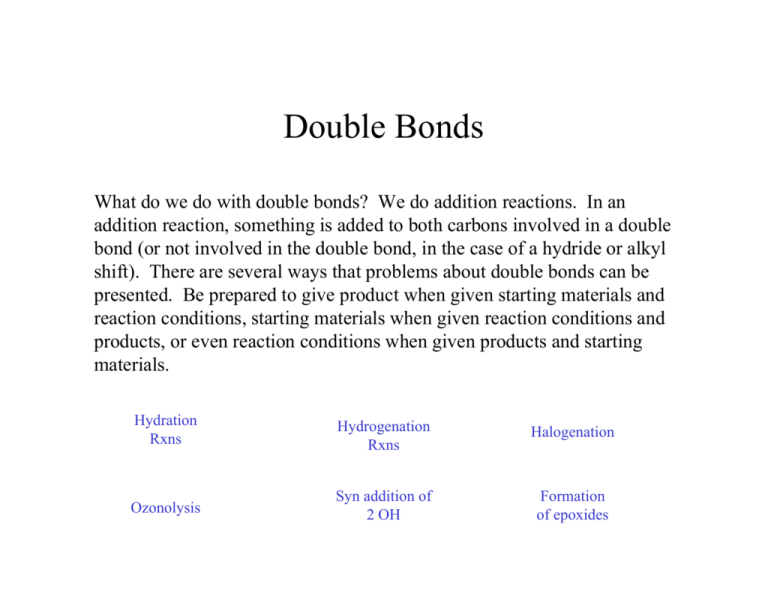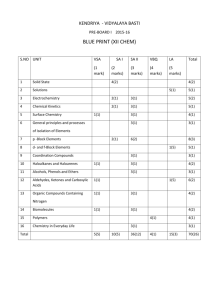Double Bonds
advertisement

Double Bonds What do we do with double bonds? We do addition reactions. In an addition reaction, something is added to both carbons involved in a double bond (or not involved in the double bond, in the case of a hydride or alkyl shift). There are several ways that problems about double bonds can be presented. Be prepared to give product when given starting materials and reaction conditions, starting materials when given reaction conditions and products, or even reaction conditions when given products and starting materials. Hydration Rxns Hydrogenation Rxns Halogenation Ozonolysis Syn addition of 2 OH Formation of epoxides Hydrations Adding water across a double bond, H on one side, OH on the other Markovnikov: OH on side where most stable carbocation would be H H2SO4 HO H mechanism H2O H If 1 or both carbons become stereocenters, a mixture of stereoisomers will be obtained Anti-Markovnikov: H on side where most stable carbocation would be H 1) BH3 2) H2O 2 H OH mechanism H NaOH, H2O This is syn addition, so you will get a mixture of enantiomers if one or both carbons are stereocenters Hydration Mechanisms • Markovnikov addition H2O H OH2 H OH2 H H H2SO 4 H2O HO H H HO H H H – Note that the initial protonation can occur on either face of the double bond and addition of water can occur on either side of the carbocation, so there is no stereoselectivity in this reaction (form a mix of stereoisomers) • Anti-Markovnikov addition H BH2 H ‡ H BH2 H BH2 1) BH3 H Note: this is syn addition due to the 4-centered transition state, but it can happen on either face of the double bond, so a mixture of enantiomers forms if there are no other stereocenters in the molecule H H 2) H2O 2 NaOH, H2O OH H It’s magic! Not really, but you don’t need to know the details of this part of the mechanism. See page 292 in the book for details Hydrogenations Add an H to each side of the double bond H H2 catalyst H H H This is syn addition, so if either or both carbons becomes a stereocenter, you will see a mixture of enantiomers Catalyst can be Ni, Pt, Pd, Pd/C. This is hetergeneous catalysis. You are not responsible for the mechanism. Halogenations or Halohydrin Formation Halogens add through three-membered ring intermediates. In the case of bromine, the bromonium ion. H Br Br2 H + enantiomer Br This is an anti addition, so if stereocenters are formed you will get a mixture of enantiomers You can also add one halogen atom and one other nucleophile, if the halogenation is done in the presence of species that can act like nucleophiles. H Br2,H2O or HOBr HO H + enantiomer Br Nucleophile attacks more substituted carbon. This is still anti addition. Ozonolysis • Ozonolysis proceeds through a cyclo-addition product. Note that the cyclo-addition can take place on either face of the double bond, but the same products result from either addition. H R' O R'' R O 1)O3 O H R R' R'' • This, then, rearranges and breaks apart according to step 2 – Reductive H R R' O O 1)O 3 2)Zn or R'' CH 3 S O O O H R R' R'' H R O R' H R' R'' C O +O C R R'' CH 3 – Oxidative H R R' R'' O 1)O 3 2) H2O2 O H R O O O R' R'' H R O HO R' R'' R' C O +O C R R'' IMPORTANT: Must know mechanism for cyclo-addition step, but not rearrangement-cleavage steps Syn addition of a diol (2 –OH) • Another cyclo-addition mechanism, this uses KMnO4 or OsO4 to add two hydroxyl (-OH) groups across the same face of a double bond O O O Mn O R R H Mn O KMnO4 H O O O R' R'' H R R' R'' + R'' R' O O Mn O HO OH + H R R' R'' R H HO O • Again: you are responsible for the cyclo-addition mechanism, but not subsequent mechanistic steps. Note that the two stereoisomers formed are enantiomers if no other stereocenters exist in the molecule and the compound is not meso. • OsO4 works the same way. R'' R' OH Formation of Epoxides (a.k.a. Oxiranes) 1. Peroxyacids R= H O RC H O O H R CH3 O O RCOOH R' + H R R' R'' R H Cl R'' R' O others R'' Notice the attack can be above or below the plane of the bond. This is important for asymmetric double bonds (form stereoisomers) 2. Intramolecular ether formation OH O H RH C C R' Br R'' NaOH O RH C C R' Br R'' O H R R' R'' Notice the formation of only a single stereoisomer and the back-side attack SN2 mechanism.








